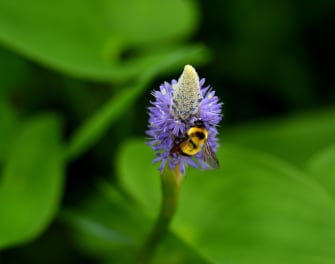Perhaps the hardest working creature in nature is the bee. With 416 species in our area, they provide a necessary function for any healthy garden. The choices you make now, in the early spring, will determine how beautiful your landscape creations become. Why not make attracting bees part of your vision.

Understand how bees thrive
Before we dive into how to bring bees to your garden, it’s important to understand the benefit they bring. First, the diligent worker bee leaves the hive in search of food for the queen. In pursuit of valuable nectar, the bee may visit your flowers to collect nectar (used for honey production). In that process, pollen sticks to the body of the bee and it's transported to another plant of the same variety and completes the first step in reproduction. This is known as pollination. The results are beautiful abundant flowers and healthy trees in your yard that bear fruit. While bees mostly get the credit for this process, it can also be completed by butterflies, wasps, moths, flies and beetles. Almost all these pollinators are attracted by the same species of plants.
The Other Wildlife
When planning your your landscape, it's important to diversify just like mother nature does. The time to think about your mix of flowers, trees and shrubs is now in early spring. We at Decker's Nursery continue to emphasize the importance of diversity and it remains one of our core values with landscape design.
Some of our customers enjoy the explosion of wildlife as much as the colorful displays of plant color. Similar to bees, hummingbirds feast on nectar too. Beginning now and until May, the hummingbird will be migrating from the southern Mexico and Panama area to as far north as Canada. It’s widely believed that hummingbirds come back to their birthplace annually, so you could be seeing the same birds in your yard season after season. How cool is that!
What To Plant
Bees love color. Consider planting groups of flowers together (so they can be seen from the air) and multiple varieties in the same place. This is helpful to the bee because different species have different preferences and different shaped tongues. Offer choices in your “bee buffet.”
Some varieties include the cornflower, azalea, coreopsis, sunflower, poppy, black-eyed Susan, aster, rhododendron, bee balm, goldenrod, hawthorn, lobelia, lupine, milkweed, wild indigo, wild mint, sunflower, turtlehead, wild geranium purple coneflower, and foxglove.
Don't forget about those trees and shrubs. They’ll benefit from pollination too. For all your hard planting work, you can quite literally enjoy the fruits of your labor. Imagine a basket of apples, blackberries, blueberries, sweet cherries and honeydew melons all grown in your backyard!
Making a comfortable sanctuary for your garden helpers will make the gardening experience much more enjoyable and productive. Focus on providing the necessities of food and shelter, and mother nature will reward you with a yard you’ll be proud of and enjoy.
